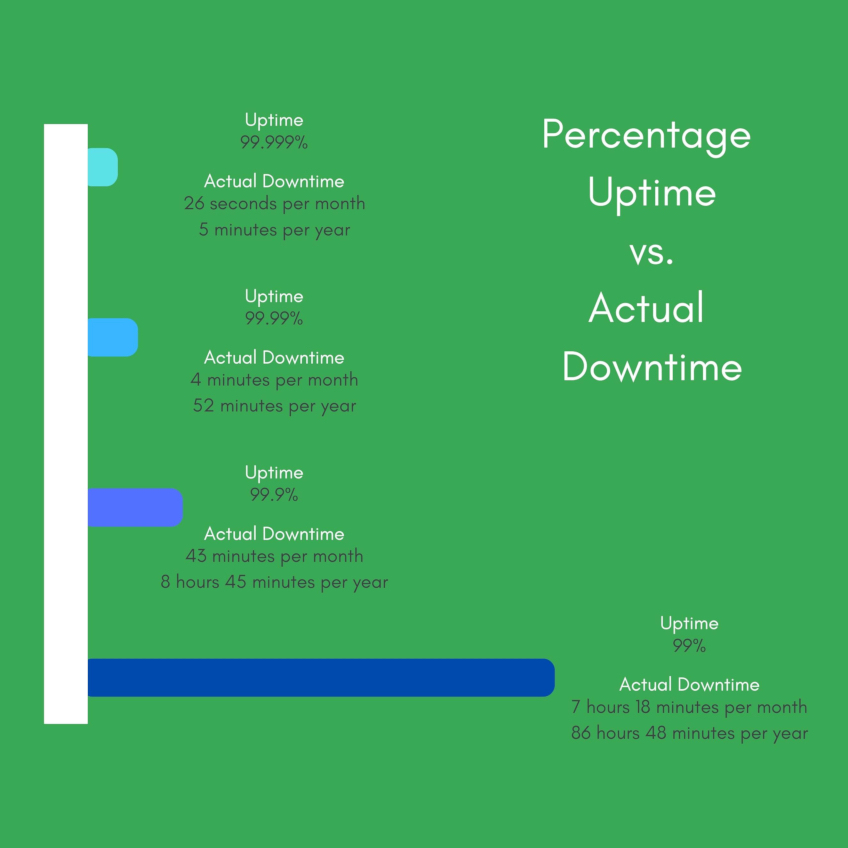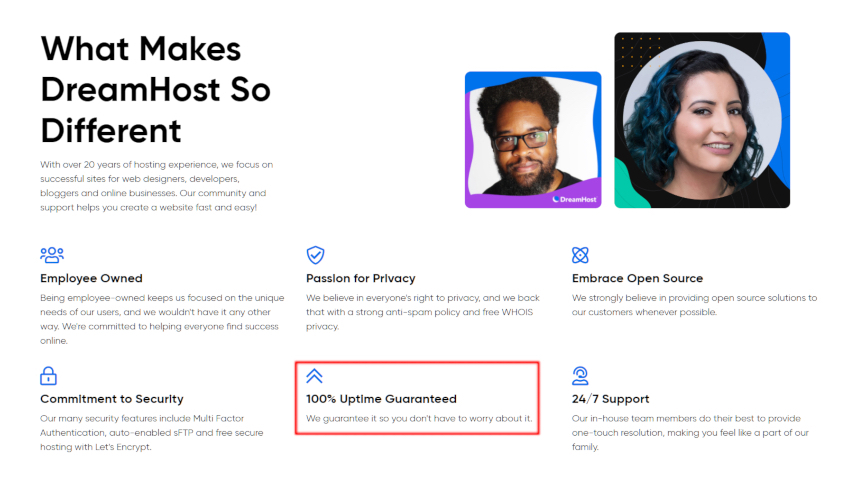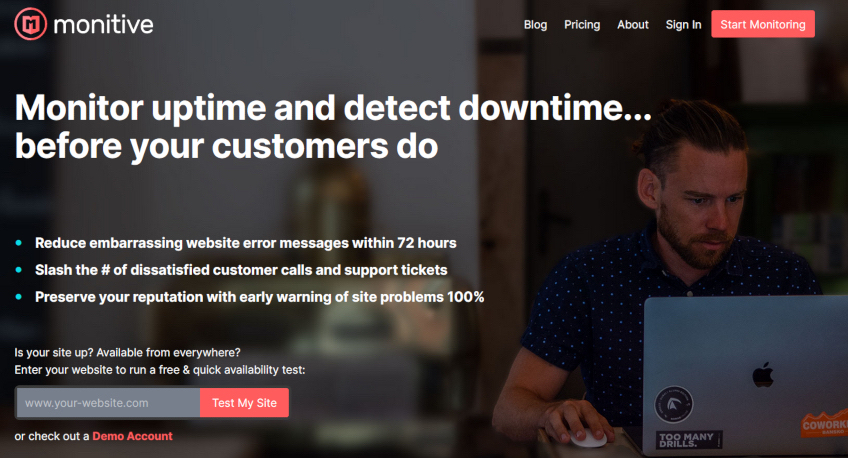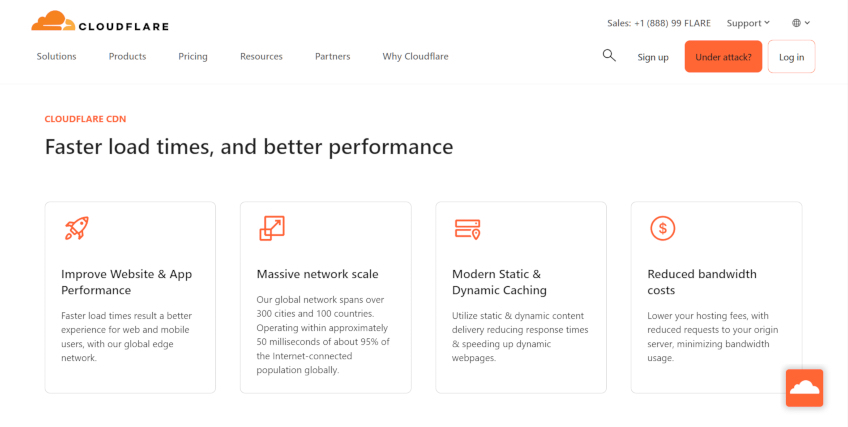Uptime is the most crucial part of hosting your website. It should be the first thing you look at when evaluating the quality of a potential hosting provider, followed by customer support and overall reviews.
The top hosting options that we currently recommend are:
- DreamHost — 99.95% uptime
- Hostinger — 99.956% uptime
- SiteGround — 99.999% uptime
- Bluehost — 99.89% uptime
- ScalaHosting — 100% uptime
What Exactly is Uptime?
Uptime is a percentage metric indicating how much time your website’s server is operational in a given month. High uptime rates suggest reliable hosting. However, verifying these claims is tricky, as most providers advertise high uptimes as a selling point.
In this guide, we’ve identified our top hosting choices based on verified uptime averages and customer reviews to help you make the best choice for your website.
Why is Uptime Important?
To say that today’s consumers are impatient is an enormous understatement, especially when it comes to browsing company websites.
If a user lands on your website and it doesn’t load properly or right away, here’s what happens, according to a 2021 survey by Fullstory:
- 77% of online consumers are likely to leave without completing a transaction if they encounter a website error.
- 60% are unlikely to go back to the website if they had a bad experience, such as encountering an error or slow loading times.
- 65% say they trust a business less when they experience a problem using a website or mobile app.
Every second that your website is down has a direct and long-lasting impact on the success of your business. This is why finding the best web hosting provider is so critical.
It’s also important to understand the language associated with uptime. Uptime percentages represent how much time per month your website is operational. A 99% uptime rate might sound good, but if you translate that into actual time, you’ll quickly realize that it’s not so acceptable to be down for 36 seconds every hour, for example.

If your site was up 99% of the time, it would be down for more than three and a half days over the course of one year. And although the industry standard for uptime is 99.9%, there’s still a big difference between 99.9% and 99.99% uptime rates.
Best High-Uptime Web Hosting Providers
While uptime should be your number one consideration, it’s not the only important aspect of a web host. Technical support is also essential.
When your site inevitably goes down at some point, you’ll want a provider that is easily accessible and acts quickly.
DreamHost

With a 100% uptime guarantee, DreamHost offers a promise unmatched by its competitors. But even with such a significant pledge, DreamHost delivers some of the most affordable plans on the market today.
Plus, if DreamHost ever fails to meet its promise, it will credit you one day of hosting for every hour of downtime—up to 10% of your next renewal fee.
As with most hosting providers, however, there is a catch to this policy. DreamHost only assesses downtime once you open a support ticket reporting the problem. That’s why you need a web monitoring service that will notify you whenever your site goes down—but more on that later.
Currently, over 1.5 million websites use DreamHost for web hosting. DreamHost also offers a 97-day money-back guarantee, which is the best we’ve seen in the industry. You can read more about its services in our full Dreamhost review.
Hostinger

Hostinger is a top-rated web hosting service that’s been around for nearly 20 years. That’s about 100 in internet years, so it’s safe to say this company has strong expertise in hosting.
You’ll find WordPress, cloud, shared, and VPS hosting plans on Hostinger, which gives you plenty of options to find the right fit. It also has incredibly affordable rates, with paid plans starting at $1.99 per month. It even offers a free plan, though its features are understandably limited.
Hostinger has a 99.99% uptime guarantee for all of its plans and will provide a credit of 5% of your monthly hosting fee if it fails to deliver on this promise. However, if you read the fine print, you’ll see the phrase, “as solely determined by us” snuck in there.
This means that Hostinger gets to decide whether it has met its uptime obligations or not, and there’s a long list of downtime exceptions that it doesn’t count. This practice is somewhat standard across web hosts, though the specifics of what they consider and don’t consider as qualified downtime will vary.
Still, even with uptime guarantee caveats, Hostinger is an excellent choice for web hosting. It provides 24/7 customer support, a user-friendly interface to manage your account, easy scalability between plans, and a website builder that’s simple to use. Users will also appreciate its transparency, as the company publishes its uptime history and incident reports for anyone to view.
To learn more about this provider, you can check out our in-depth Hostinger review.
SiteGround

SiteGround is one of the most reputable names in the web hosting industry. It has outstanding customer service and it delivers 99.999% uptime rates.
The reason why SiteGround’s uptime rates are so strong is because of the technology that it uses—i.e., Linux containers that remain stable during unexpected traffic surges. This technology is resource-efficient, meaning that servers won’t be overloaded easily.
SiteGround’s staff also leverages technology to proactively monitor all of the servers in-house. This monitoring system makes it quick and easy for SiteGround to identify and fix any errors that are causing downtime. Furthermore, by actively monitoring servers, it can predict potential problems and prevent them before any downtime occurs.
Additionally, SiteGround uses AI to prevent brute-force attacks that can cause downtime. This solution can stop up to 2 million attacks per hour across all servers.
Shared hosting plans from SiteGround start as low as $2.99 per month. To read more about its pricing and services, take a look at our full SiteGround review.
Bluehost

Bluehost is a lifesaver for website beginners who feel intimidated by web hosting. It offers a user-friendly interface, a guided walkthrough of its features, and automatic installation for WordPress sites. That means it’s super easy to get started.
And not only is it a great starter web host, but it also has additional features and hosting plans for whenever you’re ready to scale up. Once you outgrow the Basic plan, there are three other shared hosting plans available. And if you outgrow those, too, you can then choose from VPS hosting and dedicated hosting.
While Bluehost offers many great features, especially for beginners, it does have some drawbacks:
- It regularly delivers 99.9% uptime but it doesn’t guarantee its uptime rates.
- It can be more costly than other hosting providers since its packages don’t include features like backups or SSL certificates.
- Its customer service is not at the same level as other providers on our list.
You can read more about this provider’s pricing and services in our full Bluehost review.
ScalaHosting

ScalaHosting is another rock-solid web host provider to consider. It offers a 30-day money-back guarantee, no questions asked. It will also issue you a refund for any month that doesn’t meet its 99.9% uptime guarantee.
This is impressive, considering that many other providers only refund a small percentage of your monthly fee if they don’t meet their stated uptime. On top of that, it has maintained 100% uptime over the past six months, based on our own independent verification.
ScalaHosting also offers several hosting plan types, including shared, email, WordPress, and reseller hosting, as well as managed cloud VPS.
Furthermore, ScalaHosting is unique in terms of cloud VPS customization. While it offers pre-made plans, it also allows you to create a bespoke hosting plan based on the exact resources you need.
For example, you can select how many CPU cores you want and specify how much RAM and SSD space your site needs. Based on the figures you provide, it will automatically create a custom quote for your plan. This is an incredible resource if you already know what you want for your site.
Understanding Uptime “Guarantees”
A high uptime guarantee is a selling point of web host providers, but it can be misleading. A 99.9% uptime guarantee doesn’t truly mean your site will be up and running 99.9% of the time. It usually means that the provider will credit you for any downtime below that promise instead.
Most hosting companies offer a high uptime guarantee, but what they mean by that can vary significantly. This is the time to pull out your magnifying glass and carefully inspect the fine print to understand exactly what each provider offers.
Many uptime guarantees have contingencies, such as:
- Not counting planned maintenance as downtime
- Capping the amount of credit provided
- Not providing credit if downtime is due to a natural disaster
- Not counting downtime unless you open a support ticket for it
It’s these little details that matter when it comes to choosing the best web hosting provider.
Even with a great uptime guarantee, the amount of credit you receive is insignificant to the amount of money your site loses due to that downtime. However, the willingness to offer a strong guarantee is a good sign that the provider is confident in its uptime performance.
What Causes Downtime?
There’s a common adage that states that death and taxes are the only guarantees in life, but website downtime may be the closest third that exists. It’s a frustrating and unavoidable part of having a website.
Even the best web hosting providers have outages. Here are some common causes of downtime:
- Scheduled maintenance
- Server overloads
- Security threats
- Hardware issues
- Software issues
- DNS issues
- CMS issues
- Power outages
- Natural disasters
- Human error
Surprisingly enough, that the last one on the list—human error—is one of the biggest threats to your uptime. Up to two-thirds of website downtime can be attributed to humans breaking the website in one way or another.
Some of the most common human errors that can bring a site down include the following:
- Configuration mistakes—Incorrect server or database settings can make a site inaccessible
- Code errors—Bugs or poorly executed updates can disrupt functionality
- Accidental deletion—Deleting critical files or database entries can crash a site
- Poor security practices—Weak passwords or outdated software can expose a site to hackers and lead to downtime
- Overloaded resources—Failing to scale server resources to meet traffic demand can slow or crash a site
- DNS misconfigurations—Incorrect DNS settings can make a website unreachable
The best way to protect your website from these mistakes is to educate yourself and your employees on best practices, such as software updates and strong passwords, and ensure only qualified staff can access critical files.
How to Improve Your Website Uptime
While certain causes of downtime are out of your hands, there are steps you can take to ensure high uptime rates for your website.
Choose a Reliable Hosting Provider
The first step to improving your website uptime is to choose the best web host for your needs. While uptime guarantees are important, you also need a provider that offers 24/7 support. Customer support is your lifeline when your website goes down, and a support team that’s easy to reach is essential to getting your site back up and running.
We’ve vetted the providers included in this list, and they’re an excellent starting point for your web host research.

Use a Website Monitoring Service

A website monitoring service is like a personal watchdog for your website. It tracks your site’s uptime, speed, and overall performance and instantly alerts you when something goes wrong. You can then contact your provider to see what steps are being taken to get your site back up and running. Website monitoring can also help you track your website’s overall uptime to ensure you’re getting the level of performance your web host provider guarantees.
Upgrade Your Hosting Plan Type
The type of web hosting plan you choose will impact the performance of your website, including uptime. We’ve broken down four common plan types and explained their pros and cons to help you find the best option for your website.
Shared hosting
Shared web hosting plans split resources such as storage, bandwidth, and processing power among all the sites on the server. This creates a low-cost plan option but also makes your website more susceptible to downtime. If one site experiences a traffic spike or other problem, it can affect the performance of the other sites sharing that same server.
Shared hosting is a popular choice for small and medium-sized websites due to its affordability. However, it may lack the performance and security features you want for your website.
Dedicated hosting
With dedicated hosting, your website gets its own server. This means all the server’s resources such as CPU, RAM, and storage are yours alone—providing higher performance and security. That said, your site will still be susceptible to maintenance-related downtime, but issues such as traffic spikes won’t take your site down.
This sounds like the perfect choice, right? Well, it can be as long as you have the budget and experience for it. Dedicated hosting is significantly more expensive than other hosting plans and often requires more technical expertise to manage.
VPS hosting
VPS hosting plans provide a more advanced shared hosting service. With a VPS, which stands for virtual private server, you share a physical server with other websites but have a dedicated portion of the server’s resources. This means your site is protected from the bandwidth or security issues of other sites on the server, which improves your uptime.
VPS hosting is the Goldilocks option between shared hosting and dedicated hosting. It provides more customization and better uptime than shared hosting but is less expensive than dedicated hosting.
Cloud hosting
Cloud hosting works differently than the other hosting options on this list. It uses a network of interconnected virtual servers to meet your website’s needs. This plan offers great uptime and performance because your site can be shifted to another server in case of failure or increased traffic.
Cloud hosting plans generally operate on a pay-as-you-go pricing model. This makes it flexible and easily scalable, but it’s potentially costly depending on your site’s usage.
Use a CDN (Content Delivery Network)
A content delivery network, better known as a CDN, is a system of strategically located servers that distribute your website’s content to users based on their geographic location. By serving content from the nearest server, a CDN significantly accelerates your website’s load times.
CDNs can also absorb traffic spikes, which reduces the load on your primary server and lowers the risk of downtime due to overwhelming demand.

A CDN isn’t a replacement for a web host, but it does provide a valuable supplemental service that can improve your site’s uptime. It’s a smart choice for ecommerce, high-traffic, and media-rich websites.
Conclusion
Your website is only as good as your web hosting, so finding a provider that combines high uptime with excellent customer support is critical. These are our top recommendations for high-quality web host providers:
If our reviews are somehow not enough to sway your final decision, be sure to spend time reviewing each provider’s site. Read their uptime guarantees closely and check out customer reviews on trusted sites like Clutch and G2 to learn more about other people’s experiences with the hosting companies. In the end, try to find one that you can afford with the highest uptime, best performance, and greatest customer support.
